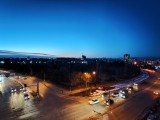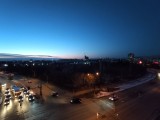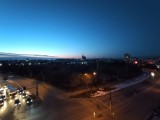Realme 8 Pro review

Quad-camera with a high-end primary and 3x lossless zoom
The real star of the Realme 8 Pro is its quad-camera on the back and specifically, the primary shooter. We are talking about the 108MP main camera, which uses Samsung's ISOCELL HM2 sensor and in addition to the expected top-notch photo quality, it is also advertised for its 3x lossless zoom. The rests of the snappers are the usual mid-range bunch - an 8MP ultrawide cam, a 2MP macro snapper, and a 2MP depth sensor.

Let's talk about the main camera. It is based on Samsung's 1/1.52" ISOCELL HM2 sensor with 0.7µm pixels and Super-PD autofocus, and is coupled with f/1.9 6P lens. Just like the HM1, HM2 uses nine-pixel binning tech and can do up to 3x lossless zoom. It can also shoot stills at up to 12000x9000 pixel resolution and record videos up to 4K@120 fps.
The 3x in-sensor lossless zoom helps preserve details and colors without over-sharpening by taking 12MP photos and mapping the zoomed area. The image processing here is tweaked by Realme to take eight consecutive 12MP shots, which are then enhanced with the aid of an algorithm to increase clarity. Realme claims this process is superior to that of some telephoto modules in terms of sharpness.

Realme also introduces a new Starry Mode for astrophotography time-lapse videos. There is also a new Tilt-shift time-lapse video, which uses an algorithm to capture tilt-shift photos and videos. These shots simulate a miniature world by keeping parts of the image out of focus. The final new additions possible via the new sensor are a bunch of portrait filters including Neon Portrait, Dynamic Bokeh Portrait, and AI Color Portrait.
The ultrawide camera uses an 8MP Hynix HK846 sensor behind f/2.3 lens and 1.12µm pixels. Night Mode is available, here, too.
The two small shooters include a 2MP OmniVision OV02B sensor with f/2.25 aperture and fixed focus at 4cm for macro shots, and a 2MP GalaxyCore GC02K0 depth sensor.
Finally, there is a 16MP f/2.5 selfie camera with fixed focus, a downgrade from the 32MP imager the Realme 7 Pro had at the front.

The camera app is the familiar Oppo/Realme one with a few tweaks for the latest version. There are fewer menus - most of the modes are now on the main rolodex, which is good. It offers AI Scene Enhancement (also known as Chroma Boost or Dazzle Color) - it's like an advanced HDR mode, which may stack several images to offers even further improvements in the dynamic range, but the most prominent "improvement" is the higher color saturation.
In the Expert mode you get to tweak exposure (ISO in the 100-6400 range and shutter speed in the 1/8000s-32s range, 2s for the ultrawide), white balance (by light temperature, but no presets), manual focus (in arbitrary 0 to 1 units with 0 being close focus and 1 being infinity) and exposure compensation (-2EV to +2EV in 1/6EV increments).

You do get to shoot on the main and ultrawide cams in this Expert mode but switching them is handled in a truly bizarre way. You get the familiar 1x-2x-5x selector, but that doesn't operate the actual cameras - it's a digital zoom from whichever camera you've picked from the tree selector on the opposite end of the viewfinder. Indeed, the trees switch cameras and once you select a module from there, no focusing distance considerations will auto-switch it - that's good.
One thing that bothered us a lot is the Video section. If you've selected 4K or 1080p@60fps, you won't see a 0.6x switch for the ultrawide camera as these resolutions aren't supported. The only way to enable it is to switch to 1080p@30fps from the advanced settings. And switch back to 4K when you are done. Other makers do this hassle-free by shooting at the maximum resolution available, when a camera can't do, say 4K, but Realme seems to have stumbled with this thing here.
Photo quality - daylight
The default 12MP photos shot with the main camera are good - they are detailed enough, free of noise, with excellent contrast, lively if a bit over-saturated colors, and properly impressive dynamic range.
Hopefully, you weren't expecting flagship-worthy quality though. The images exhibit this oil-painting effect on foliage, bricks and even cars, where the high-frequency detail was smeared by the (noise) processing algorithms. It's not that bad, in fact - it reminds us of the recent iPhone 12 series, but it could have been better.
Yes, the 12MP photos are plenty good for the mid-range class and we couldn't ask for more, really. But honestly, we expected them to be slightly better given the flagship camera sensor. Maybe Realme will do better with a firmware update down the road, maybe it won't.
Realme also offers an AI Scene Enhancement toggle (previously known as Chroma Boost and Dazzle Color) within the camera app. It usually makes an HDR photo with eye-popping colors, depending on the scenes, of course.
Well, here is a bunch of AI-enhanced photos. When the algorithm detects Blue Sky or Greenery you can clearly see the saturated colors. They are currently off the charts, but if that's what you are looking for, by all means - you keep the AI on.
You can shoot in 108MP, but our recommendation is to stay away from this mode. It takes about 5 seconds to save an 108MP image and then it will turn up soft and noisy, poor in detail and dynamic, and yet large in size - 30MB or more. The 108MP photos look a lot like (somewhat smart) upscale from the default 12MP output and we can't think of one reason why anyone should try it.
Realme came up with an improved image processing that makes the best from the new 108MP sensor and allows for 3x lossless zoom. The viewfinder has default 3x and 5x zoom toggles.
Well, imagine our surprise when we looked through the 3x zoomed photos and found them awesome. Sure, the processing sometimes struggles to extract intricate detail and may give you oily foliage, but still, these 3x photos are as good, or even better, as many of the 8MP tele shooters we've seen them take.
The zoomed images are rich in detail, with well-handled noise, great dynamic range, superb contrast, good colors (once again, a bit punchy), and overall - very pleasant look. If someone asked us to guess if these were taken with a real telephoto camera, we would have said yes. Good job, Realme!
The 5x images are digitally zoomed over the 3x and yes, you can tell that, but they look incredibly good since they've been cropped and upscaled from the 3x photos. The images are much better than any simple 5x digital zoom and once again we really appreciate the effort Realme has put into offering high-quality magnification on this wide-angle camera.
The 8MP photos saved by the ultrawide-angle camera are averagely looking. The resolved detail is mediocre - some has been taken away by the noise reduction. The colors are somewhat off with a noticeable reddish tint, the dynamic range is not that good, while the contrast is okay-ish.
We've seen better ultrawide shooters, but the ones within Realme 8 Pro price bracket offer similar quality, so no one should be expecting more.
The 2MP macro camera has its focus fixed at 4cm and shooting a sharp picture is nearly impossible task. Even if you manage to get the distance right and keep your hand steady, the 2MP images would be soft, noisy, and with unsatisfactory color saturation.
The 12MP portraits shot on the main camera with the help of the 2MP depth sensor are impressive - the subjects are sharp and detailed, with accurate colors and their separation from the background is done proficiently. The simulated blur looks pretty good, too, and overall, we are pleased with these portraits.
The selfie camera on Realme 8 Pro uses a 16MP Quad-Bayer sensor behind f/2.5 lens. The focus is fixed. The photo quality is good, as far as it can be when the phone is saving the photos in 16MP instead of the natively binned 4MP. The resolved detail is expectedly average, but everything else is great - contrast, colors, dynamic.
The 16MP portrait selfies are as detailed as the regular selfies, with acceptable separation, nice blur, and lively colors.
Photo quality - low-light
The main camera takes very balanced 12MP photos at night. There is plenty of resolved detail, probably because of the gentle noise reduction, which leaves a lot of noise but also a ton of detail intact. The color saturation is kept close to the real deal, the contrast is good, and the photos do look as we saw the scene with our eyes.
You can observe many clipped highlights, but that's because the phone uses no other enhancements when shooting in its default Photo mode.
Turning the AI enhancement will grant you an HDR photo with a brighter look and with restored highlights. The detail and noise levels are the same, as is the color saturation. Shooting such photo doesn't require extra time and won't go overboard with the colors, so you may leave the AI-enabled at night.
Night Mode is available, of course, but it takes from 5 to 10 seconds to process and save the photo. We guess the 108MP sensor finally took its toll on the mid-range chip and lead to a bottleneck when stacking, processing and saving multiple images. But are they worth it?
Well, the Night Mode photos are even brighter, the noise is gone and that's why they look softer, but we also observed more extracted fine detail at some spots. Yet, the wait was really annoying, some of the highlights remain clipped, and the photos aren't a massive improvement over the AI ones, so this is probably one of the few occasions where we won't recommend using Night Mode.
The 8MP low-light photos from the ultrawide camera are noisy, soft and dark even if they retain good colors. Without further enhancements, those are rather unsaleable.
The AI enhancement isn't of much help when it comes to ultrawide photos at night - it saves a bit brighter but similarly awful photos.
The Night Mode, on the other hand, does wonders for ultrawide-angle photography. It cleans all the noise, brings more detail, restores clipped highlights, and brightens everything to a very usable extent. You should definitely use Night Mode here.








Night Mode ultra-wide cam, 8MP
The lossless zoom doesn't work at night - you'd be getting a simple 3x digital zoom and it doesn't look good.
Once you're done with the real-world samples, head over to our Photo compare tool to see how the Realme 8 Pro stacks up against other phones.



Realme 8 Pro against the Realme 7 Pro and the Redmi Note 10 Pro in our Photo compare tool
Video quality
The Realme 8 Pro captures videos with its main camera and ultrawide snappers. The main camera records video up to 4K at 30fps and there's 1080p at both 30fps and 60fps. The ultrawide shooter is limited to 1080p@30fps video capturing and you can use it only when you set the default resolution (from Settings) to 1080p@30fps.
You get the option to choose between the h.264 and h.265 codecs.
Electronic stabilization is available only at 1080p@30fps mode on both cameras.
The Realme 8 Pro is super generous with the bit rates - the. 4K footage gets 50Mbps while 1080p/30fps is allocated a similarly above average 20Mbps when using the h.264 codec. The audio bitrate is always 320kbps, and the sound is stereo.
The 4K videos captured with the main camera are stellar - they are rich in detail, low on noise, with perfectly accurate colors, great dynamic range, and commendable sound. We suspect the boost in video quality since Realme 7 Pro is because of the missing always-on EIS when shooting in 4K.
The low-light 4K30 fps videos from the main camera are pretty good for this class, too. The noise is kept reasonably low, and this did not come at the expense of fine detail. There is also balanced exposure and preserved colors.
Realme is also offering this AI Highlight video mode. It is shot in 1080p and doesn't offer much improvement rather than literally highlighting the light sources giving them slightly better look and color saturation.
There is no lossless zoom for when shooting videos, sorry.
The 1080p clips from the ultrawide camera are average (probably because of the always-on EIS). The resolved detail is barely enough, the colors are a bit over-saturated, the dynamic range and the contrast are good, though.
Here's a glimpse of how the Realme 8 Pro compares to rivals in our Video compare tool.



2160p: Realme 8 Pro against the Realme 7 Pro and the Redmi Note 10 Pro in our Video compare tool
Reader comments
- GiwMeQuikkCharge
- 13 Oct 2024
- 35D
Just bought this phone second-hand for less than $100 (~90). Have to say that this for my use case is 100% as well-rounded as it gets. The small size hits instantly, together with the rounded backsides gives a really thin and small feel. I also ...
- Brijesh
- 13 Feb 2024
- rJT
My front camera not working properly
- dani
- 10 Oct 2023
- avx
bro the camera is not very bad






































































































































